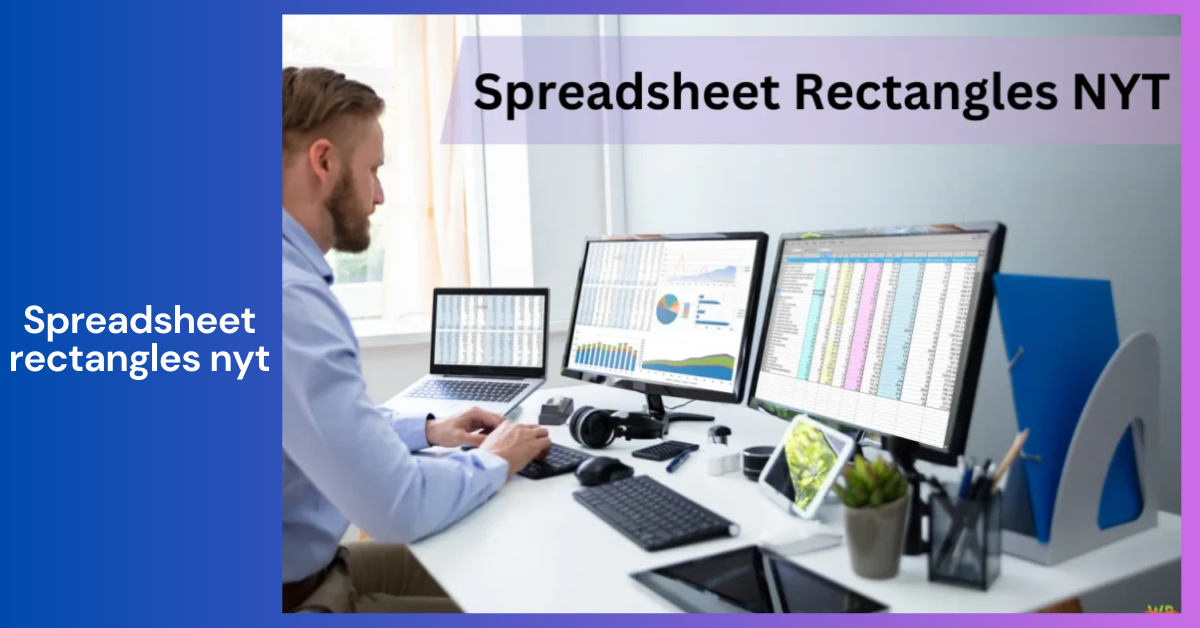
In recent times, the term “spreadsheet rectangles NYT” has gained attention, especially among puzzle enthusiasts and those who are curious about its meaning.
The clue “Spreadsheet rectangles NYT” in crossword puzzles refers to “cells,” which are the basic rectangular units in a spreadsheet where data is entered and managed, such as in Excel or Google Sheets.
While it may sound like a complex or technical term, it’s actually something that many people come across regularly, especially in the context of puzzles like those in the New York Times (NYT).
This article will break down what “spreadsheet rectangles NYT” refers to, why it’s important, and how it relates to everyday spreadsheet use. We’ll also explore some related terms and provide insights that go beyond what you might find elsewhere.
What Does “Spreadsheet Rectangles NYT” Mean?
Breaking Down the Term
At its core, “spreadsheet rectangles” refer to the cells within a spreadsheet. When you think about a spreadsheet, whether it’s in Microsoft Excel, Google Sheets, or any other similar software, it’s essentially a grid made up of horizontal rows and vertical columns.
The intersection of these rows and columns forms cells, which are often described as rectangles due to their shape.
The “NYT” in “spreadsheet rectangles NYT” refers to the New York Times, specifically the newspaper’s famous crossword puzzles. In these puzzles, clues often reference terms related to everyday tools and technologies, including spreadsheets.
Therefore, the clue “spreadsheet rectangles” is likely guiding solvers towards the answer “cells,” which are the basic rectangular units within a spreadsheet.
Why Is This Term Popular in NYT Crossword Puzzles?
The New York Times crossword puzzles are known for their clever and often tricky clues that require solvers to think outside the box.
Clues like “spreadsheet rectangles” are designed to test your knowledge of common tools like spreadsheets, while also challenging you to see these tools in a different light. The popularity of this clue in the NYT crossword puzzles stems from its simplicity and the universal familiarity people have with spreadsheets.
The Importance of Spreadsheet Rectangles in Everyday Use
What Are Spreadsheet Rectangles Used For?
Spreadsheet rectangles, or cells, are essential to the functionality of a spreadsheet. Each cell can hold data, whether it’s text, numbers, dates, or formulas.
This data can then be organized, analyzed, and manipulated in various ways to perform tasks such as budgeting, data analysis, and record-keeping.
For example, if you’re creating a budget, each cell might represent an expense category or a specific amount of money.
You can use formulas to add, subtract, multiply, or divide these amounts, making it easy to see where your money is going and where you might need to make adjustments.
How Do Spreadsheet Rectangles Improve Efficiency?
The rectangular cells in a spreadsheet make it incredibly easy to organize large amounts of information. By arranging data into a grid format, you can quickly compare and contrast different pieces of information, identify patterns, and draw conclusions.
This is especially useful in business settings, where spreadsheets are often used to track financial data, inventory, customer information, and more.
Related Terms to “Spreadsheet Rectangles NYT”
Cells
As mentioned earlier, cells are the basic building blocks of a spreadsheet. Each cell is identified by a unique combination of a column letter and a row number (e.g., A1, B2).
Cells can hold various types of data, and they can also be formatted in different ways to make the information more understandable.
Rows and Columns
Rows and columns are the horizontal and vertical divisions in a spreadsheet, respectively. Rows are typically numbered, while columns are labeled with letters. Together, they form the grid that contains the cells.
Formulas
Formulas are mathematical expressions that perform calculations on the data in your spreadsheet. They can be simple, like adding two numbers, or complex, involving multiple cells and operations.
Formulas are one of the most powerful features of spreadsheets, allowing you to automate calculations and data analysis.
Range
A range in a spreadsheet refers to a group of adjacent cells. For example, the range A1would include all the cells from A1 to A10. Ranges are often used in formulas to perform calculations on multiple cells at once.
Advanced Uses of Spreadsheet Rectangles
Conditional Formatting
Conditional formatting is a feature in spreadsheets that allows you to apply different formats to cells based on the data they contain.
For example, you might want to highlight all cells with a value greater than 100 in green, or flag any cells with a negative value in red. This makes it easier to spot trends or outliers in your data.
Pivot Tables
Pivot tables are a powerful tool in spreadsheets that allow you to summarize and analyze large amounts of data quickly.
They work by grouping your data into categories and then calculating summaries, such as sums or averages, for each category. This can help you make sense of complex datasets and identify key insights.
Data Validation
Data validation is a feature that helps ensure the accuracy and consistency of data entered into a spreadsheet. By setting rules for what data can be entered into a cell, you can prevent errors and maintain the integrity of your data.
For example, you might restrict a cell to only accept numbers within a certain range or only allow text in a specific format.
The Role of “Spreadsheet Rectangles” in Problem Solving
How Spreadsheet Rectangles Help in Decision Making
Spreadsheet rectangles are more than just data containers; they are a vital part of the decision-making process.
By organizing data into cells, you can easily perform calculations, create charts, and analyze trends. This allows you to make informed decisions based on real data rather than guesswork.
For example, a business might use a spreadsheet to track sales data over time. By analyzing this data, they can identify which products are performing well and which ones might need to be discontinued. They can also use the data to forecast future sales and set targets.
Using Spreadsheet Rectangles for Collaboration
Spreadsheets are also an excellent tool for collaboration. With cloud-based tools like Google Sheets, multiple people can work on the same spreadsheet simultaneously, making it easy to share information and collaborate on projects.
Each person can add data, make changes, and see updates in real-time, all within the familiar grid of cells.
Unique Interpretations and Insights
Seeing Spreadsheet Rectangles as Building Blocks
One unique way to think about spreadsheet rectangles is to see them as the building blocks of your data. Just as bricks are used to build a house, cells are used to build a spreadsheet. Each cell, or rectangle, holds a piece of information that contributes to the overall picture.
When you arrange these cells in a meaningful way, you create a structure that helps you understand and manage your data.
The Puzzle-Like Nature of Spreadsheet Rectangles
Another interesting perspective is to think of spreadsheet rectangles as pieces of a puzzle. Just like in a puzzle, each cell has its place, and when you put them together correctly, they form a complete picture.
This puzzle analogy can be particularly helpful when working with large datasets, where the challenge is to arrange the data in a way that reveals patterns or insights.
Conclusion
The term “spreadsheet rectangles NYT” might seem like a niche reference at first, but it actually touches on something fundamental to how we use spreadsheets in our daily lives.
By understanding what these rectangles represent and how they can be used effectively, you can unlock the full potential of your spreadsheets, whether you’re solving a crossword puzzle or managing complex data.
Spreadsheets are powerful tools, and the cells, or rectangles, within them are the foundation of that power. From organizing data to performing complex calculations and enabling collaboration, these rectangles are integral to the way we work with information today.
So, the next time you come across the term “spreadsheet rectangles NYT,” you’ll know that it’s more than just a puzzle clue—it’s a gateway to better data management and analysis.
FAQs about Spreadsheet Rectangles NYT
What is the purpose of “spreadsheet rectangles” in a crossword puzzle?
The term “spreadsheet rectangles” in a crossword puzzle, particularly in the New York Times, typically refers to the cells in a spreadsheet. It’s a clever way to describe the rectangular shape of these cells, which are the building blocks of any spreadsheet.
How do I use spreadsheet rectangles effectively?
To use spreadsheet rectangles (cells) effectively, start by organizing your data into rows and columns that make sense for your project. Use formulas to perform calculations and consider using features like conditional formatting, pivot tables, and data validation to analyze and visualize your data.
Why are spreadsheet rectangles important in data analysis?
Spreadsheet rectangles are crucial in data analysis because they allow you to organize and manipulate data in a structured way. By using cells to hold data and formulas to perform calculations, you can analyze large amounts of information quickly and accurately.
Can I collaborate with others using spreadsheet rectangles?
Yes, you can collaborate with others using spreadsheet rectangles, especially with cloud-based tools like Google Sheets. Multiple users can work on the same spreadsheet simultaneously, making it easy to share information and work together on projects.
How can I make my spreadsheet more visually appealing?
To make your spreadsheet more visually appealing, use formatting options like bold text, colors, and borders to highlight important information. Conditional formatting can also help make key data stand out. Additionally, consider using charts and graphs to visualize your data.





